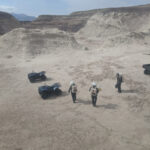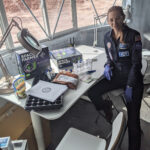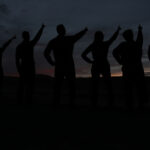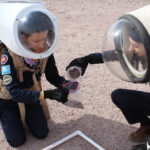Sol 4
As much as we like to focus on the astronauts’ out on their daring feats of glory, it’s important to remember – there would be no mission without Houston, waiting to solve any problems.
In the last two days, we’ve learnt the value of “Habcomm” – our name for the crew member in charge of Hab communications to the three-person crew that is on EVA. Having a point person is valuable for many reasons, not in the least that it frees up the responsibility to listen from 1-2 other crew members who can now use that time to conduct science or operations work (or, more shockingly, take a shower).
On our first two practice EVA’s on Sol 3, myself (Executive Officer Hume) and Commander Dickstein acted as Habcomm’s for each other’s EVA’s. When practice EVA Crew #1 forgot our map, rather than scrubbing the mission, Habcomm directed up to the location of the practice science using the map in the Hab and the GPS we had taken with us, as well as a variety of landmarks along the way. When on practice EVA 2, both Hariharan and Dickstein lost their comms due to a drained radio battery, I, as Habcomm, was able to confirm Hernandez’ decision to return to the Hab for safety purposes and kept it touch with practice EVA Crew #2 to ensure their uneventful return.
And that was all done in one morning.
Without Habcomm, there is no authority coming from the Hab itself, no one to check the regulations that the full crew operates by and no way to help the crew out on EVA should alterations need to be made in the planned expedition. They’re a source of both information and decisiveness, helping a crew balance their desire to do science with the prerequisite safety of the sim.
And as we all have drilled into our heads. Safety first, then sim, then science.
Today was the EVA #3, the first science EVA. The crews took on their permanent configurations. Crew #1 is now Dickstein, Ettlin, and Coultrup. Crew #2 is Hume, Hernandez, and Hariharan. The intent was to begin the EVA at 14:00, however due to a prediction for high winds, we gathered together around 22:00 last night and created a new EVA Plan that would begin at 09:00, instead.
The intent of the EVA is twofold. Firstly, it would be the first science mission to our site #1. We chose a region near Lith Canyon, north on Cow Dung Road and a short walking distance along a ridge. In that area, there is a dried up riverbed, with specific geologic importance. The type of regolith we would find there would be useful to both Ettlin’s geological survey and my own astrobiology study, looking at the microorganism distribution we could find. In brief, the protocol is to sample from four different sites, and do the sampling by taking and combining four additional localized mini-samples at each chosen point. In addition to that science, an operations study was going to look for the best possible locations at this scientific site for emergency sheltering during an extreme weather event, such as a Martian dust storm. Identifying and evaluating these sites based on a pre-determined criteria is built into every mission, in order to make sure the crew members are safe, even when out in the field. I’m sure you all remember the beginning of “The Martian.” No Mark Watney’s at MDRS, please!
With these night-before changes made, we woke up on Sol 4 excited to begin our first true expedition. After a hearty oatmeal and rehydrated fruit breakfast, we moved onto the EVA protocol our team designed for our simulation. Although several items are mandatory, such as a five-minute minimum in the airlock prior to exiting the hab, there are significant amounts of personal preference in how above and beyond that the crew will go. Our protocol, as we designed it, is below:
The Protocol
Note: This is our protocol as of the beginning of Sol 4, and is in progress. A final operational protocol for EVA’s will be included in our “Participants’ Handbook” that we are making available online after our mission.
1. Sunscreen up! Mars is bright.
2. Gather all equipment and sterilize as needed. More equipment into airport in container for transport to rover.
a. Map
b. GPS (x2)
c. EVA bag (including emergency medical)
d. 3 radios per participant, 3 extra redundant radios per participant
e. Science Equipment as needed
i. Protocol for Emergency Shelter Identification
ii. Baggies for soil samples as needed
iii. Spade for soil samples
iv. Grid for taking soil samples at each location
f. TP, just in case
g. Water
3. Get into flight suits, use the bathroom, and find your callsign baggie (callsign baggie’s include earpiece, cloth to clean your helmet, and gloves)
4. Medical check with HSO
a. Blood pressure
b. Pulse/Oxygen
c. Temperature
d. Heart Rate
e. Mental Health Check
5. Put on microphone and bandana. Recommendation: put bandana over microphone to ensure snugness and that it won’t fall out on EVA
6. Check comms between both Habcomm/Hab and EVA participants. Radios should be fully charged! Switch out if not.
7. Put on Boots.
8. Planetary Protection Protocol with XO
a. First week is on “minimum requirements” PPP
b. Have you sterilized any equipment used to take soil samples?
c. Use alcohol wipe/sanitizer on bare hands
d. Enter the “clean room” – the room outside of the airlock
e. Shut clean room door
9. Clean EVA helmet as needed using provided spray and your own microfiber cloth.
10. Put on your assigned spacesuit, adjust if needed. Recommendation: make sure bulk of the weight is sitting around your hips, use shoulder straps only to balance.
a. If you are wearing a two-piece, place the collar and lower the helmet, then attach pieces.
11. Turn on spacesuit. Attach airflow tubes to helmet and turn on air flow. Adjust airflow as needed. Reseal Velcro flap.
12. Check comms once again to ensure that they are audible inside the suit with airflow. If needed, turn down the fan and reseal Velcro to ensure audio is clear.
13. Later on, a higher level of planetary protection protocols will be entered here.
14. Buddy check: EVA participants should check everyone’s comms, airflow, Velcro flap being closed, and that no skin is exposed.
15. One member of the Hab crew will let the EVA crew into the airlock and seal it behind them.
16. EVA Protocols
a. Habcomm measures 5 minutes of airlock time
i. Notifications are given at 1 minute, 30 seconds, and 0.
ii. At 1 minute, all non-mission chatter ceases.
iii. A clear indication is given at 0 to exit the airlock.
b. No more non-mission chatter is permitted while Hab is in sight.
c. Record and communicate to the HAB
i. ATV serial number
ii. Rover charge and hours before and after EVA
iii. GPS coordinates at destination
d. Upon return
i. Request permission to enter Hab grounds
ii. Request permission to enter Hab airlock
e. Wait 5 minutes on Habcomm’s clock to open airlock to Hab
f. Clean helmet before putting away
g. Plug in spacesuits to charge
EVA 3
Seems like we thought everything out, doesn’t it?
Five minutes into sim.
“Habcomm, we have a problem.”
After about five minutes, we started losing communications entirely with the EVA crew. There was interference during each attempted communication, but no clear language received. There was no clear way to even know if they were talking to each other or to me.
I attempted basic communication as Habcomm, asking them to repeat vital messages, shorten to keywords, and testing different hand radios for better reception. However, it soon became clear that we had little way to help them. After about ten minutes, the radios suddenly crackled into clarity.
EVA Crew #1 had returned to the local area around the Hab, at a junction named Pooh’s Corner. There, we finally could speak to each other again. They requested help deciding whether to come back or to choose a new location, since it seemed to break the cardinal rule of safety to go out of radio distance.
Our Crew Engineer, Hariharan, who is largely in charge of EVA operations, immediately began looking on the map to identify alternate sites. Since the original site was a riverbed, he wanted to find an equivalent as similar as possible. However… each of the coordinate numbers is about eight digits long, so I quickly returned to the main Hab (from the Science Dome, where I was… dum dum dum… writing this) in order to help him. I noticed a small streambed labeled as a walking EVA only zone, just north of Pooh’s corner to the East. Parking the rover and the ATV on the main road and then walking to the streambed would be not only feasible, but faster, and likely entirely in radio range.
I advised the crew to park at the GPS coordinates for the crossing of the streambed and road, and while they were en route, confirmed with the outpost that switching locations was allowed. Not only was it allowed, but we were able to get confirmation that going out of radio communications due to distance on science EVA’s is not only acceptable, but fairly nominal.
With that in mind, the Commander and I interfaced via radio one last time and decided that EVA Crew #1 should head to the original GPS location near Lith Canyon and the dried riverbed. We also confirmed that they had cell phones on their person (for the ‘gram) in case a true emergency were to come up.
One tenant of life in the sim is that if we have a solution for a problem on Mars, then we can negotiate the rules of the sim. I.e., on Mars, going to the bathroom wouldn’t be an issue… so we are allowed to break sim for that, vs. hazarding a medical infection.
In this case, radios on Mars would clearly be able to go any distance within the bounds of acceptable travel locations, and so, going beyond radio range is a way to negotiate the sim against reality. Should an out-of-sim emergency happen, they have a method with which to contact for help.
Safety first. Check.
Shortly after that, EVA Crew #1 left radio reception once again. Comms were silent for nearly two hours, during which time other report-writing, botanical, and operations activities took place. We also agreed to choose back-up locations for future EVA locations, should any other problems come up, and mapped out using dry erase all of our locations of interest onto the map we keep in the Hab communal area. For a while, all we could do was wait.
Then, at 11:30, the radios crackled back on. We heard chatter first between the EVA crew members, then a call out to Habcomm.
“Commander to Habcomm, permission to enter the Hab grounds?”
The rest, thankfully, was nominal. After confirming visuals on the returning EVA crew, Hariharan, Hume, and Hernandez waited in the clean room of the Hab, and after five minutes, were able to greet the crew and help them spacesuit-down. Soil samples were immediately placed in freezer’s in the Science Dome to maintain their integrity of microbiomes present, and the entire crew was able to gather for both lunch and a debriefing on the EVA.
There is a significant amount of media focus on the astronauts, with Habcomm, or rather, Houston, remaining a more tertiary figure. A mechanical sounding voice over a speaker. Although everyone at NASA and other space agencies knows different, it is easy for a casual viewer to misunderstand the dire need for an effective and efficient Habcomm. Performing an EVA is a risk, no matter whether you do it on real Mars or simulated Mars, and it’s essential for the crew taking on that risk to have the support of the rest of their crew.
During today’s missions, we not only learnt best practices for how to continue being the best Habcomm we can be for our EVA crews as we rotate through the role, but how vital the role is, and how the voices we often only hear over the comms systems in movies are necessary teammates, not only for the desired science and engineering to be accomplished, but also for the safe return of our Martian astronauts.
Fun fact of the day! Our rover’s name is Perseverance!






You must be logged in to post a comment.